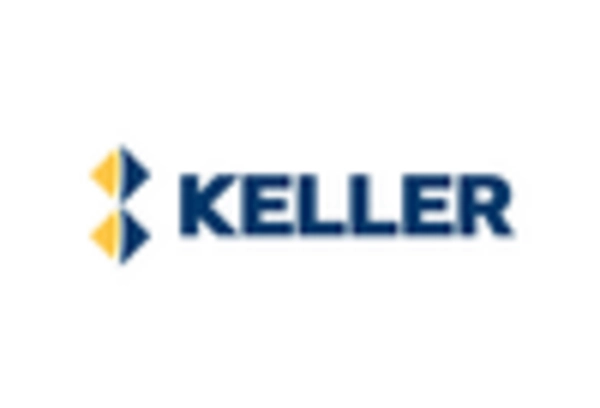Urbanization and Population Growth
Urbanization continues to be a significant driver of the soil stabilization market. As the population in urban areas increases, the demand for infrastructure development rises correspondingly. This urban expansion necessitates the construction of roads, bridges, and buildings, all of which require stable soil conditions. The U.S. Census Bureau indicates that urban areas are expected to grow by 13% by 2030, leading to increased investments in infrastructure projects. Consequently, the soil stabilization market is likely to benefit from this trend, as effective soil stabilization techniques are essential for ensuring the longevity and safety of urban infrastructure.
Government Infrastructure Initiatives
Government initiatives aimed at improving infrastructure are significantly impacting the soil stabilization market. Federal and state governments are investing heavily in infrastructure projects, including highways, bridges, and public transportation systems. The U.S. Department of Transportation has allocated over $300 billion for infrastructure improvements over the next five years. This influx of funding is likely to create substantial opportunities for soil stabilization solutions, as stable soil conditions are critical for the success of these projects. As a result, the soil stabilization market is expected to see increased demand driven by government-led infrastructure initiatives.
Growing Awareness of Soil Erosion Issues
The increasing awareness of soil erosion and its detrimental effects on the environment is driving the soil stabilization market. Soil erosion can lead to significant land degradation, affecting agricultural productivity and water quality. As stakeholders recognize the importance of soil conservation, there is a growing emphasis on implementing effective soil stabilization techniques. Educational campaigns and research initiatives are highlighting the benefits of soil stabilization in preventing erosion. This heightened awareness is likely to result in increased investments in soil stabilization solutions, thereby propelling the growth of the soil stabilization market.
Technological Innovations in Soil Stabilization
Technological advancements play a crucial role in shaping the soil stabilization market. Innovations such as the development of advanced chemical stabilizers and geosynthetics have enhanced the effectiveness and efficiency of soil stabilization methods. These technologies not only improve soil strength but also reduce construction time and costs. The market for geosynthetics alone is projected to reach $10 billion by 2027, indicating a robust growth trajectory. As construction companies increasingly adopt these innovative solutions, the soil stabilization market is poised for expansion, driven by the need for more efficient and reliable stabilization techniques.
Rising Demand for Sustainable Construction Practices
The soil stabilization market is experiencing a notable shift towards sustainable construction practices. As environmental concerns gain traction, construction companies are increasingly adopting eco-friendly methods to minimize their carbon footprint. This trend is reflected in the growing preference for soil stabilization techniques that utilize natural materials and reduce waste. According to recent data, the market for sustainable construction is projected to grow at a CAGR of approximately 10% over the next five years. This shift not only aligns with regulatory requirements but also appeals to environmentally conscious consumers, thereby driving demand within the soil stabilization market.
















